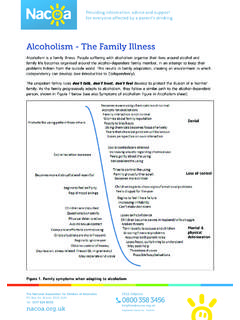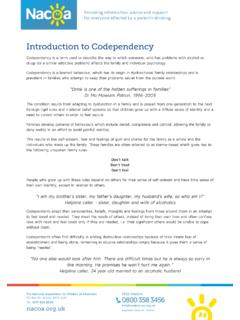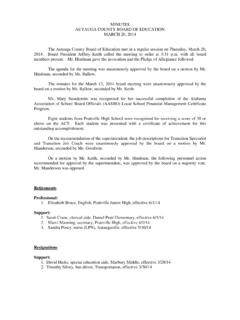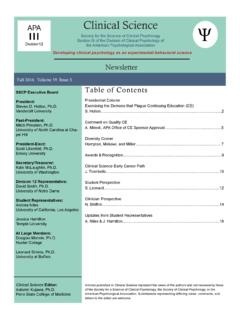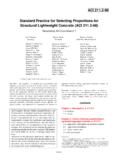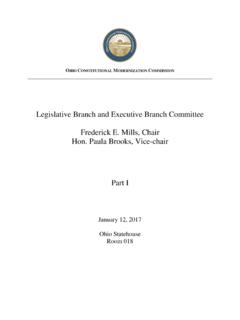Transcription of H C Children of alcoholics: R A E S E the UK’s largest ...
1 Children of alcoholics :the UK s largest surveyCatherine Gilvarry interprets survey findings from the National Associationfor Children of alcoholics and reviews the literature to give an evidencebase for diagnosing and helping Children of alcohol-dependent parentsSep/Oct 05 is estimated that 12% of men and 3% of women in theUK are dependent on alcohol (Coulthard et al, 2002).This equates to about 3million men and 800,000 is a disorder which affects the whole family and parents, partners and Children are often left to dealwith the alcoholic alone. Alcohol Concern estimates that 920,000 childrenare living in a home where one or both parents misusealcohol (Hidden Harm, 2000).But the National Societyfor the Prevention of Cruelty to Children puts the figureseven higher, suggesting between 300,000 and of alcoholics living with at least one alcoholicparent in the UK.
2 Abundant literature has shown that Children ofalcoholics CoAs can be profoundly affected by theexperience of trying to negotiate their own lives whilemanaging to live with, or avoid, the alcoholic parent(s).But there are considerable problems with the example, much of the early research was carried outwith CoAs recruited because their parents werehospitalised for treatment of their alcohol they were drawn from clinical samples and are notrepresentative of Children of other types of alcoholics ,such as those whose dependency is less severe or whoescaped identification by healthcare or social services. Other research has drawn participants from collegesand universities. These CoAs also represent a subgroupof CoAs, a relatively successful subgroup, so are notrepresentative of the broader population of CoAs either.
3 Studies on CoAs have, sadly, been characterisedby small sample sizes, selective sampling and absenceof control groups. The consequences of these weaknessesin methodology are that their findings have beengeneralised to all CoAs and we still know relatively littleabout the broader population of CoAs. Many Children brought up by alcoholic parents seemto be at increased risk for a host of negative outcomes,including substance abuse, antisocial behaviours, lowself-esteem, depression, anxiety and eating disorders. It is important to note that none of these factors arespecific to CoAs nor are they uniformly observed in CoAs:risk factors such as parents having mental disorders,anxious or ambivalent attachment, childhood abuse andfamily dysfunction can generate similar outcomes. Yetthere has been a veritable cottage industry of researcharound CoAs for the last few decades.
4 Giglio & Kaufman (1990)reviewed the literatureon CoAs and found few methodologically-sound questioned the specificity of the psychosocialproblems attributed to a history of parental alcoholism,stating that much of the appeal of the ACoA movementis in the applicability of its issues to Children from anydysfunctional family. The definitive question of theuniqueness and specificity of the problems of being theadult child of an alcoholic is still unanswered . Garver & Hollon (1991)suggested that disturbedfamily environments, thought to be caused by parentalalcoholism, appear to be equally prevalent amongfamilies exposed to other major stressors. They referredto this as consequential non-specificity . So do CoAsexperience a unique set of circumstances which setsthem apart as a discrete group? With this question in mind, Nacoa the NationalAssociation for Children of alcoholics commissionedresearch to investigate the psychosocial characteristicsof CoAs, Children of parents with mental disorders, andchildren of parents with neither of these problems.
5 AA NNAATTIIOONNAALL SSUURRVVEEYYwas carried out and 23,378adults were asked if they had grown up in a home whereone or both parents was (1) alcoholic or (2) sufferedfrom a mental-health problem. A total of 4,884 peopleresponded positively and from this number a total of746 people completed and returned questionnaires. Of this figure, 412formed the controlgroup, 96 were childrenof parents with mentaldisorders (CoMD), 176 were Children ofalcoholics who did nothave mental disorders(CoAs) and 62 werechildren of alcoholicswith comorbid mentaldisorders (CoAMD).MMEENNTTAALL--HHEEAALLTTHH PPRROOBBLLEEMMSS. Among peoplereceiving active treatment for problem drinking, up to70% meet the criteria for a lifetime diagnosis ofdepression (Schuckit et al, 1997), and 34-54% of peoplewith an anxiety disorder have lifetime diagnoses of analcohol-use disorder (Kessler et al, 1995).
6 Studies havealso shown higher levels of anxiety, depression andeating disorders in CoAs (Cuijpers et al 1999, Moos &Billing 1982). Some researchers have suggested that itis the comorbid disorder, rather than the alcoholism perse, which creates difficulties for CoAs. Work has shownthat Children of parents with depressive and anxietydisorders but no alcoholism show poorer levels ofoverall functioning and higher levels of mental disorderthan comparison Children (Biederman et al, 2001). To get a truer perspective on this, we comparedour participants in the control group, in the groupconsisting of Children of alcoholics , and in the groupconsisting of Children of parents with mental-healthdisorders on a variety of mental-health measures andfound the results shown in the panel on the next GGiillvvaarrrryy PhDis senior lecturer at RoehamptonUniversity School of Humanand Life Sciences.
7 She recently joinedthe board of trusteesof Nacoa (UK)TTRRAAIINNIINNGGM ental disorders experienced as a childControls CoAsCoMDSig addiction3% From this we can see that the only significantdifferences between groups are for (1) consideredsuicide where both the CoAs and CoMDs did this moreoften than controls, but without significant differencebetween the CoAs and CoMDs and (2) CoAs are morelikely than both the other groups to have experiencedan eating disorder as a child. Mental disorders experienced as an adultControls CoAsCoMDSig addiction3% this table we can see that CoAs are muchmore likely to have experienced alcoholism and drugaddiction as adults. CoAs and CoMDs do not differsignificantly on considered suicide and mental-healthproblems but both score significantly higher thancontrols.
8 We also found that there were no significantdifferences between CoAs and CoAMDs, suggesting thatit is the alcoholism, rather than the comorbid disorderwhich impacts on mental health in CoAs. Goodwin (1985)reported that the prevalence ofalcoholism among male relatives of alcoholics (25%) isfive to eight times higher than the estimated prevalenceof alcoholism in the general male population (3%-5%).We analysed the data for males only and showed of adult males reported a history of alcoholismcompared with of the control group and ofthe CoMDs, confirming Goodwin s findings. FFAAMMIILLYY DDIISSCCOORRDD. Studies examining familydiscord and violence in alcoholic households have beenvery variable and Sher (1991)found the reported rate ofchild abuse varied between 0% and 92%. The Nacoa study showed that CoAs experiencedsignificantly more discord and violence in their homelives than either the controls or the CoMDs.
9 This arguesagainst the consequential non-specificity notion that the disturbed family environments, thought to becaused by parental alcoholism, appear to be equallyprevalent among families exposed to other majorstressors as forwarded by Garver & Hollon (1991). CoAsdo suffer more. AANNTTIISSOOCCIIAALL BBEEHHAAVVIIOOUURRSS. Higher levels ofoppositional and conduct disorders, as well as atendency to engage in more delinquent behaviours thancontrols (Havey & Dodd, 1995),have often been foundin CoAs. While we did not measure antisocial behavioursspecifically, we did ask whether participants had everbeen in trouble with the police. We found that there wasno significant difference between groups, either aschildren or adults. SSOOCCIIAALL SSUUPPPPOORRTT. Alcoholism is the family secretand disclosure of what is going on within the family canbe extremely difficult for CoAs, both because they areoften in a self-protective denial of the situation andbecause they have learned that telling someone outsidethe family is tantamount to betrayal of the parent, whichcould result in great difficulty for the child should thedisclosure be uncovered.
10 Help received outside the familyHelp receivedACoAACoMD Sig diffTeacher/church worker6%8%. table shows that CoAs are significantly lesslikely to receive help from services than CoMDs, butthere was little difference between CoAs ( ) andCoMDs (21%) getting help from friends or family. So CoAs often grow up in isolation and without becomes the guiding principle for the familywhich becomes socially isolated, with a subsequentnegative impact on family functioning, friendshipformation and relationship development for the Examining mental disorders in CoAsand CoMDs, we showed that there are few differencesbetween these groups but both groups experiencemore mental-health problems than the controls. Thiscould support the point that it is the comorbid disorder,rather than the alcoholism, which creates difficulties forCoAs.
